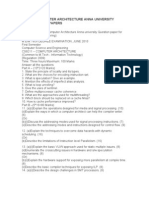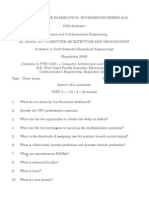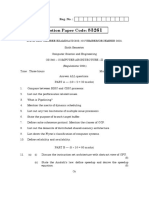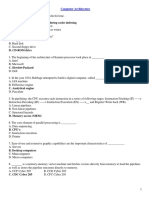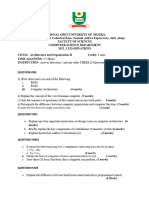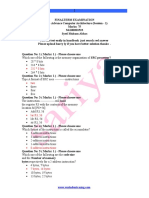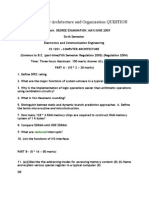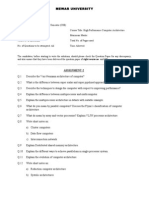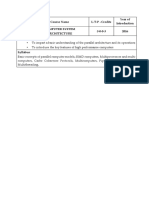0 ratings0% found this document useful (0 votes) 19 views2 pages2009.-. - ICS 311 - Advanced Computer Architecture - EXAM
COMPUTER ARCHITECTURE QUESTIONS
Copyright
© © All Rights Reserved
We take content rights seriously. If you suspect this is your content,
claim it here.
Available Formats
Download as PDF or read online on Scribd
UNIVERSITY OF NAIROBI
UNIVERSITY EXAMINATIONS 2008/20
JOOL OF COMPUTING
LIBRARY
First Semester Examination for the
Degree of Bachelor of Science (Computer Scienc
ICS311 : Advanced Computer Architecture
TIME:
DATI
‘There are five (5) questions on this paper. Candidates are required to attempt Question 1
and any TWO other questions
Question 1 (20 marks)
a) The classical von Neumann model of the computer can be enhanced to exploit
parallelism in the. computation process. Explain clearly the concepts of available
parallelism and utilized parallelism. Give an example of available functional
parallelism naming the computer architecture that exploits that type. (4 marks)
b) Distinguish between instruction level and threa el available parallelism. Describe
two parallel computer ‘architectures, one that exploits instruction level and a second
that exploits thread level parallelism, (4 marks)
6) Describe the concurrent “C” access scheme that is applicable on an interleaved
‘memory system and explain the performance advantages. (4 marks)
4) Inthe context of instruction level paraliel architectures explain i) Output dependency
and if) Anti-dependency. Explain why they are considered as false data dependencies.
(4 marks)
* ©) Explain clearly the goals of the array processor architecture on the one hand and S| iP
architecture on the other. (4 marks) |
Question 2. (15 marks)
instruction execution, (Smarks)
>) Explain the distingui is i
uishing characteristics of i) coarse-grained and ii) fine-orai
wy poseson ems)
°) Describe the NUMA architec!
sluster architecture that it addr
CC-NUMA arebitecture.
ture highlighting the limitations of the traditional
sses. Also, explain the cache coherency problem in
(5 marks)
NFORMI
UNIVERSITY OF NAIRA-�Question 3 (15 marks)
1 architectures endeavor to exploit instruction level parallelism (ILP).
f dependencies that present a challenge to
(5 marks)
a) Supersca
Explain this. Also explain the types o
effectiveness of the superscalar architecture.
by Using an illustrative diagram, describe the organization and operation of a superscalar
processor that employs direct (blocking) instruction issue as opposed to shelved issue.
(5 marks)
¢) Related to the superscalar concept, describe the idea of super-threading. (5 marks)
Question 4 (15 marks)
processor architecture, ¢.g.
a) Using an illustrative diagram, describe the classical array
(5 marks)
as employed in the Burroughs Scientific Processor computer.
and C[I:n] where n is large. Describe the
sm implemented by
processors.
(5 marks)
b) Given three vectors A[J:n], BUI:n]
performance gains realizable by employing i) pipelined parallelis
vector processor units and ii) spatial parallelism implemented by array
Explain the importance of the PE interconnection network as a design issue of the
array processor architecture. Assume an array processor with 16 PEs, compare the
two interconnection networks known as the bus and 2-D near-neighbour with wrap-
‘around in terms of two parameters, network diameter, throughput and probability of
blocking. (5 marks)
9
Question 5 (15 marks)
a) Deseribe the objectives (expected benefits) and the basic structure of the symmetric
multiprocessor system (SMP). (5 marks)
+ b) In the context of SMP architectures, explain the cache coherency problem. Describe
respectively i) the directory based and ii) the distributed cache coherency protocols.
(S marks) ~
) For an SMP, a switching network may be an appropriate interconnection system for
connecting 8 processors to a shared memory system consisting of 8 memory modules
(units). Compare two alternative switch design options, namely crossbar switch and
the Omega switch with regard to implementation complexity, bandwidth and
probability of blocking. (5 marks)

